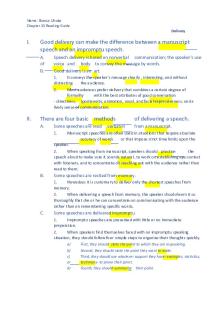Reading Guide 17-3 17-11-1 PDF

| Title | Reading Guide 17-3 17-11-1 |
|---|---|
| Course | Organic Chemistry I |
| Institution | University of Maryland Baltimore County |
| Pages | 1 |
| File Size | 55.2 KB |
| File Type | |
| Total Downloads | 92 |
| Total Views | 131 |
Summary
exam 2...
Description
Sections 17.3, 17.11 Chapter 17 Skills (Learning Objectives on Blackboard): 2, 4-7 End of Chapter Problems: 42, 49-52, 60, 62, 69 These sections begin our discussion of molecular orbital theory. We will spend most of our time in class clarifying and extending your understanding of section 17.3. This foundation will be important throughout this chapter and the next one (chapter 18). I strongly suggest that you view the Khan Academy video about butadiene before class. In class we will consider the MO description of allylic cations, anions and radicals in addition to conjugated diene systems. As we proceed throughout this chapter and the next, there will be times where either resonance or molecular orbitals will explain stability and/or reactivity. At other times, resonance alone will be insufficient and we will need to use molecular orbital theory. Section 17.11 provides our first example of an observation which requires a molecular orbital explanation. The take away message is that the HOMO-LUMO gap determines the wavelength that is absorbed – what factors influence the wavelength? For these sections, I recommend the following videos. The first two (molecular orbital theory) used to be on the Khan Academy site but are now available on youTube. The second two (UV-Vis Spectroscopy) are on the Khan Academy site. The appropriate links are available on Blackboard. Intro to Molecular Orbital (MO) Theory (12:01) – pairs with section 7.3 View for Review This video reviews molecular orbital theory from general chemistry. It starts out describing the principles of constructive and destructive interference using waves and vectors and then applies these ideas to bonding in H2. MO Theory for Butadiene (11:24) – pairs with section 7.3 Recommended Viewing This video describes the molecular orbitals of butadiene by drawing the complete MO diagram (Figure 17.9) with detailed step-by-step explanations. Additionally, it introduces and labels the HOMO and LUMO. UV-Vis Spectroscopy (11:12) – pairs with section 7.11 Recommended Viewing This video describes the UV-Vis spectroscopy and a UV-Vis spectrum and details the theory for butadiene. Only the first part, up through 7:30, is relevant for this course. Conjugation and Color (9:34) – pairs with section 7.11 Recommended Viewing This video details the theory for ethane, butadiene, and hexatriene. Only the first part, up through 5:30, is relevant for this course....
Similar Free PDFs

Reading Guide
- 11 Pages

Reading guide
- 15 Pages

Decreto 173 2001 leyes
- 11 Pages

Chapter 5 Reading Guide
- 9 Pages

The Odyssey Reading Guide
- 1 Pages

Chapter 8 Reading Guide
- 7 Pages

Chapter 15 Reading Guide
- 3 Pages

Chapter 15 Reading Guide
- 2 Pages

Burls Reading Guide
- 10 Pages

Module VI Reading Guide
- 7 Pages

Ch 3 Reading Guide
- 8 Pages

Chapter 13 Reading Guide
- 4 Pages

Ch 3 Reading Guide
- 8 Pages

Chapter 14 Reading Guide
- 2 Pages

Montana 1948 reading guide
- 3 Pages

Reading Guide T3 2021
- 2 Pages
Popular Institutions
- Tinajero National High School - Annex
- Politeknik Caltex Riau
- Yokohama City University
- SGT University
- University of Al-Qadisiyah
- Divine Word College of Vigan
- Techniek College Rotterdam
- Universidade de Santiago
- Universiti Teknologi MARA Cawangan Johor Kampus Pasir Gudang
- Poltekkes Kemenkes Yogyakarta
- Baguio City National High School
- Colegio san marcos
- preparatoria uno
- Centro de Bachillerato Tecnológico Industrial y de Servicios No. 107
- Dalian Maritime University
- Quang Trung Secondary School
- Colegio Tecnológico en Informática
- Corporación Regional de Educación Superior
- Grupo CEDVA
- Dar Al Uloom University
- Centro de Estudios Preuniversitarios de la Universidad Nacional de Ingeniería
- 上智大学
- Aakash International School, Nuna Majara
- San Felipe Neri Catholic School
- Kang Chiao International School - New Taipei City
- Misamis Occidental National High School
- Institución Educativa Escuela Normal Juan Ladrilleros
- Kolehiyo ng Pantukan
- Batanes State College
- Instituto Continental
- Sekolah Menengah Kejuruan Kesehatan Kaltara (Tarakan)
- Colegio de La Inmaculada Concepcion - Cebu